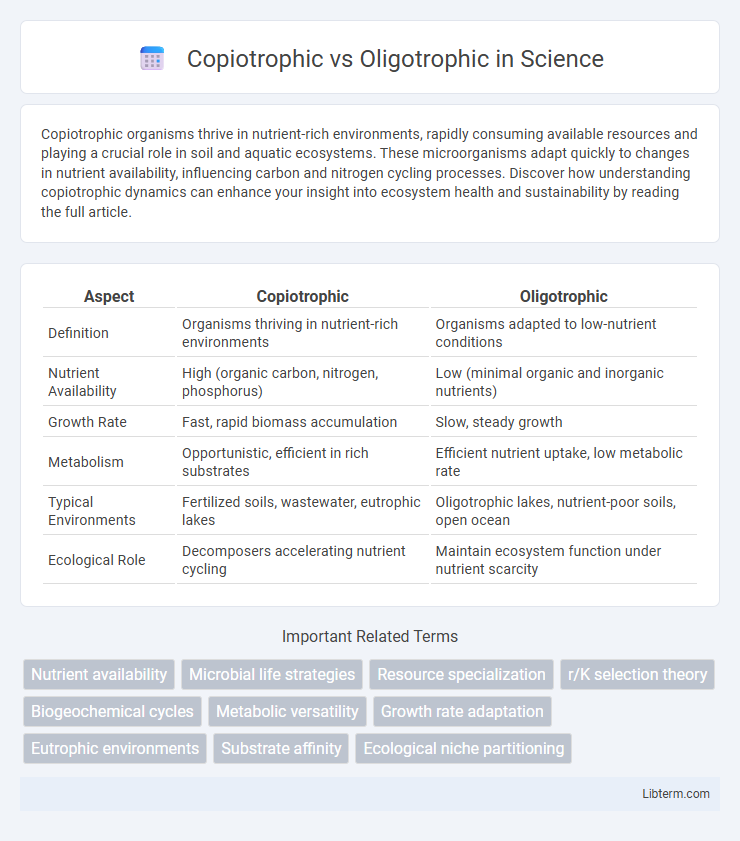Copiotrophic organisms thrive in nutrient-rich environments, rapidly consuming available resources and playing a crucial role in soil and aquatic ecosystems. These microorganisms adapt quickly to changes in nutrient availability, influencing carbon and nitrogen cycling processes. Discover how understanding copiotrophic dynamics can enhance your insight into ecosystem health and sustainability by reading the full article.
Table of Comparison
| Aspect | Copiotrophic | Oligotrophic |
|---|---|---|
| Definition | Organisms thriving in nutrient-rich environments | Organisms adapted to low-nutrient conditions |
| Nutrient Availability | High (organic carbon, nitrogen, phosphorus) | Low (minimal organic and inorganic nutrients) |
| Growth Rate | Fast, rapid biomass accumulation | Slow, steady growth |
| Metabolism | Opportunistic, efficient in rich substrates | Efficient nutrient uptake, low metabolic rate |
| Typical Environments | Fertilized soils, wastewater, eutrophic lakes | Oligotrophic lakes, nutrient-poor soils, open ocean |
| Ecological Role | Decomposers accelerating nutrient cycling | Maintain ecosystem function under nutrient scarcity |
Introduction to Copiotrophic and Oligotrophic Organisms
Copiotrophic organisms thrive in nutrient-rich environments, exhibiting rapid growth and high metabolic rates due to abundant organic carbon availability. Oligotrophic organisms adapt to nutrient-poor conditions, displaying slow growth, efficient nutrient uptake, and survival strategies optimized for limited resources. The distinction between copiotrophic and oligotrophic organisms is critical in understanding ecological nutrient cycles and microbial community dynamics.
Defining Copiotrophic Environments
Copiotrophic environments are characterized by high nutrient availability, promoting rapid microbial growth and organic matter decomposition. These ecosystems often have abundant carbon sources, nitrogen, and phosphorus, supporting fast-growing bacteria and algae populations. Common examples include wastewater-impacted waters, agricultural soils, and eutrophic lakes with elevated nutrient concentrations.
Characteristics of Oligotrophic Environments
Oligotrophic environments are characterized by low nutrient concentrations, particularly nitrogen and phosphorus, resulting in limited primary productivity and slow microbial growth. These ecosystems often exhibit clear waters with high oxygen levels and support species adapted to nutrient-poor conditions, such as certain fish and phytoplankton. Oligotrophic lakes and soils typically have stable conditions and low organic matter accumulation, influencing nutrient cycling and biodiversity dynamics.
Nutrient Availability: Key Differences
Copiotrophic environments are characterized by high nutrient availability, supporting rapid microbial growth and enhanced metabolic activity due to abundant organic carbon and nitrogen sources. In contrast, oligotrophic environments have limited nutrient concentrations, forcing microorganisms to adopt slower growth rates and specialized survival strategies to efficiently utilize scarce resources. The distinct nutrient profiles in these habitats drive different ecological functions and community compositions within microbial ecosystems.
Adaptations of Copiotrophic Microbes
Copiotrophic microbes thrive in nutrient-rich environments due to their rapid growth rates and high metabolic activity, enabled by efficient mechanisms for nutrient uptake and utilization. Their cellular machinery is adapted to exploit abundant organic carbon sources, featuring numerous transport proteins and enzymes for quick breakdown of complex compounds. These microbes often exhibit flexible regulatory systems that allow swift responses to fluctuating resource levels, optimizing energy expenditure in competitive habitats.
Survival Strategies in Oligotrophic Conditions
Microorganisms thriving in oligotrophic conditions exhibit survival strategies centered on low nutrient availability by developing high-affinity nutrient uptake systems and reduced metabolic rates to conserve energy. These organisms often produce extracellular enzymes to scavenge scarce organic compounds and maintain cellular integrity during prolonged nutrient limitation. Adaptations such as slow growth rates, efficient nutrient recycling, and dormancy enable persistence in oligotrophic environments with minimal resources.
Metabolic Profiles: Fast vs Slow Growth
Copiotrophic organisms exhibit fast metabolic rates, thriving in nutrient-rich environments by rapidly utilizing available resources for growth and reproduction. Oligotrophic organisms, in contrast, possess slow metabolic profiles, adapted to nutrient-poor conditions by conserving energy and maintaining steady growth over extended periods. These differences highlight distinct survival strategies in microbial ecology, with copiotrophs favoring rapid proliferation and oligotrophs prioritizing efficiency and endurance.
Ecological Roles and Functions
Copiotrophic organisms thrive in nutrient-rich environments, accelerating organic matter decomposition and nutrient cycling, thus enhancing soil fertility and supporting rapid ecosystem productivity. Oligotrophic organisms adapt to nutrient-poor conditions by efficiently utilizing scarce resources, maintaining ecosystem stability, and contributing to long-term carbon storage and nutrient retention. Their contrasting ecological roles balance ecosystem function by regulating nutrient availability and energy flow in diverse habitats.
Applications in Biotechnology and Environmental Science
Copiotrophic microorganisms thrive in nutrient-rich environments, making them ideal for biotechnological applications such as wastewater treatment and organic pollutant degradation where rapid metabolic activity is required. Oligotrophic microorganisms, adapted to low-nutrient conditions, are crucial for bioremediation of oligotrophic soils and nutrient-poor aquatic systems, enhancing nutrient cycling and stability in fragile ecosystems. Both strategies contribute to sustainable environmental management by optimizing microbial activity based on nutrient availability.
Future Research Directions and Challenges
Future research on copiotrophic and oligotrophic organisms must address the complex interactions between microbial communities and environmental nutrient gradients, utilizing advanced metagenomic and metabolomic techniques. Challenges include accurately predicting ecosystem responses to anthropogenic nutrient inputs and climate change, requiring integrative models that combine microbial physiology with biogeochemical cycles. Expanding knowledge of adaptive strategies in copiotrophs and oligotrophs can drive innovations in biotechnology and ecosystem management.
Copiotrophic Infographic

 libterm.com
libterm.com